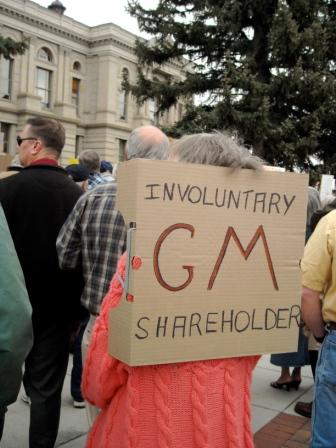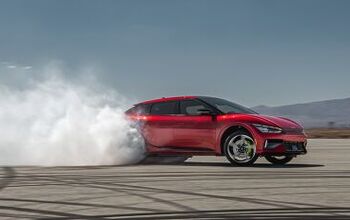GM IPO Roadshow To Begin The Day After Elections
Looking for proof that politics are an overriding concern for GM during its forthcoming IPO: look no further than a report by Reuters which claims that
GM’s roadshow is set to begin on Nov. 3 and will last two weeks, the sources said. The IPO is expected to price on Nov. 17 and debut on Nov. 18.
Now why would GM wait until the day after midterm elections to file? Well, it could be so GM has time to file 3rd Quarter financial data before offering shares to the public, but GM’s CFO has already warned that 3rd Quarter results will be worse than results from the first half of the year. In other words, waiting to file is likely to materially hurt the IPO (and taxpayers’ chance of payback). But if GM launches its roadshow the day after elections, it won’t turn the midterm election into a referendum on the auto bailout, a situation that would surely exacerbate the already-strong anti-incumbent trend in American politics. And clearly protecting craven pols is far more important than maximizing the return on “investment” for taxpayers, right?
On the other hand, the IPO’s timing might not even matter so much. After all, estimates of a $20b+ IPO are proving to be as unrealistic as we’ve always thought. According to Reuters
The final value of the IPO has not been set but one source said early plans for the IPO envisioned selling $12 billion to $16 billion in common stock and $3 billion to $4 billion in preferred stock that would convert to common stock under a mandatory provision.
And why not? Gaskin’s Iporeport on the GM offering notes that “Investors don’t like surprises,” and GM has offered plenty of unpleasant surprises. FOr example, the fact that Ed Whitacre appeared in several GM commercials led investors to believe that he would stay around post-IPO, and his recent decision to step down is hardly reassuring. Furthermore, the government and GM are clearly not on the same page, as Whitacre suggested an all-in IPO that the Treasury clearly wasn’t behind. Declining market share, “one time” gains in the first half, the Volt’s many issues, and concerns about new CEO Dan Akerson all make Gaskin’s list of worries. The conclusion:
GM should trade at a discount to Ford which means a 50% loss on the government’s “investment.”
Which, in turn, hurts GM’s chances of future success. If GM is worth less than the $50b the taxpayers invested in it, it will be almost impossible to claim that the bailout was reasonably successful. Which also helps explain why the roadshow won’t start until after elections. Like the bailout itself, GM’s IPO is turning out to be another fear-based play in which preserving the status quo (politically this time, rather than economically) overrides any other concern, such as responsibility to taxpayers. Should we have expected anything else?
More by Edward Niedermeyer
Latest Car Reviews
Read moreLatest Product Reviews
Read moreRecent Comments
- SCE to AUX Over the last 15 years and half a dozen vehicles, my Hyundais and Kias have been pretty cheap to maintain and insure - gas, hybrid, and electric.I hate buying tires - whose cost goes by diameter - and I'm dreading the purchase of new 19s for the Santa Fe.I also have an 08 Rabbit in my fleet, which is not cheap to fix.But I do my own wrenching, so that's the biggest factor.
- MaintenanceCosts '19 Chevy Bolt: Next to nothing. A 12v battery and a couple cabin air filters. $400 over five years.'16 Highlander Hybrid, bought in 2019: A new set of brakes at all four corners, a new PCV valve, several oil changes, and two new 12v batteries (to be fair, the second one wasn't the car's fault - I had the misfortune of leaving it for a month with both third-row interior lights stealthily turned on by my kid). Total costs around $2500 over five years. Coming due: tires.'11 BMW 335i, bought in late 2022: A new HID low beam bulb (requiring removal of the front fascia, which I paid to have done), a new set of spark plugs, replacements for several flaking soft-touch parts, and two oil changes. Total costs around $1600 over a year and a half. Coming due: front main seal (slow leak).'95 Acura Legend, bought in 2015: Almost complete steering and suspension overhauls, timing belt and water pump, new rear brakes, new wheels and tires, new radiator, new coolant hoses throughout, new valve cover gaskets, new PS hoses, new EGR valve assembly, new power antenna, professional paint correction, and quite a few oil changes. Total costs around $12k over nine years. Coming due: timing belt (again), front diff seal.
- SCE to AUX Given this choice - I'd take the Honda Civic Sport Hatchback (CVT). I 'built' mine for $28777.To my eye, the Civic beats the Corolla on looks these days.But for the same money, I can get an Elantra N-Line with 7-speed DCT, 201 HP, and good fuel economy, so I'd rather go for that.
- Kwik_Shift_Pro4X '19 Frontier Pro 4X. Next to nothing. All oil changes are on schedule. Got new tires at 60000 miles. Still on original brakes at 79000 miles. Those are due soon. Brakes complete estimate $1000 all in.
- Dr.Nick The cars seem really expensive with tight back seats and Cadillac was on the list of the highest price gouging dealers coming out of COVID. I don’t understand the combination, shouldn’t they be offering deals if they are not selling?































Comments
Join the conversation
Yup, here we go. Ed crying about how the taxpayers got screwed by saving 300,000 jobs and 2 million elderly persons pensions and health care with a small $50 billion rescue. Yet, where was he crying when the banks stole $750 billion and then another $4 trillion after that? Nowhere. Because that bank rescue was a bailout of his trust fund and if that didn't happen, he would have to actually get a real job instead of sitting in front of the pool typing on his computer all day.